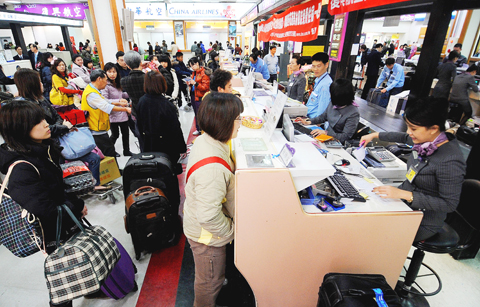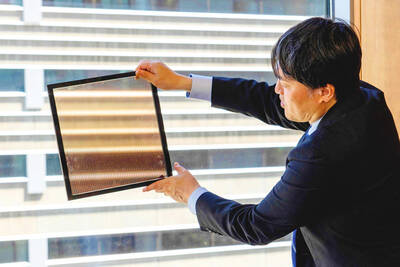Thirty-one-year-old sales executive Jenny Liu (劉彥雲) is flying to Bangkok during the Lunar New Year holiday along with five other family members.
They plan to spend around 10 days at a friend’s bungalow at Pattaya, the famous beach resort which is about a two-hour drive away from the Thai capital.
“I thought we would have to pay an extra 30 percent for tickets as air fares have all increased during the Lunar New Year,” Liu said. “But we managed to get normal fares because we booked as early as December.”

PHOTO: CHIEN JUNG-FENG, TAIPEI TIMES
“It wasn’t that people didn’t have the money to travel last year, but they put plans on hold,” said Melody Wang (王窕如), a public relations officer at Lion Travel Service Co (雄獅旅行社). “Now, the travel spending spree has begun.”
Travel agencies including Lion Travel heaved a sigh of relief as they started to see business momentum pick up in the second half of last year. Expecting even brisker sales this Lunar New Year holiday, they said revenue could grow by about 20 percent over the same period last year.
“The economic sentiment is improving, and our packages for Lunar New Year are selling like hot cakes,” said Rex Huang (黃賢在), vice general manager of Phoenix Tours International (鳳凰旅行社), the only travel company that trades on the GRETAI Securities Market.
A recent survey from 1111 Job Bank shows that more than 80 percent of companies polled plan to pay out bonuses this year, up 17.5 percentage points from last year. Average bonuses — normally handed out before the Lunar New Year — increased to 1.73 months of wages from last year’s 1.47 months.
Bolstered by bullish business prospects, enterprises across different sectors — from chipmaker Taiwan Semiconductor Manufacturing Co (台積電) to carmaker Yulon Group (裕隆集團) — are planning to take hundreds of more staff this year.
As people have bigger bonuses to spend, Phoenix Tours was looking forward to selling more high-end tour packages.
Take the company’s Dubai package for instance. The six to eight-day trip to the “Miracle in the Desert” ranges from NT$140,000 (US$4,360) to NT$230,000.
These packages are good to go as long as at least two customers sign up.
Already, six clients have paid for a Dubai trip around the Lunar New Year to see its architectural marvels, including the recently opened Burj Dubai — the world’s tallest skyscraper — Huang said.
“The prices of tour packages to Dubai didn’t drop drastically even during the financial crisis, and more people have become increasingly aware of this destination,” he said. “The launch of high-end residences and other incredible architecture have further raised its international profile.”
And smart travelers like Liu were quick to make bookings before the festive season to avoid risking paying higher fares or changing destinations because of limited seats.
AirAsia Bhd, the largest low-cost carrier in Southeast Asia, has seen its loading rate rise to more than 80 percent for all threeof its Taiwan routes during the Lunar New Year.
The airline launched its Taipei-Kuala Lumpur flights last July and its Taipei-Bangkok flights last September. Last month, it introduced its newest route between Taipei and Malaysia’s Sabah.
Although the Taipei-Sabah route is new, its passenger loading rate for the Lunar New Year exceeded 84 percent, the company said.
“We wanted to increase daily frequencies during Lunar New Year in view of the overwhelming demand, but we couldn’t because we needed regulatory approval,” said Katheleen Tan (陳凱霖), AirAsia’s senior vice president for the Asia-Pacific region.
Although latecomers may find that prices for Lunar New Year flights are higher, AirAsia’s fares are still about 20 percent lower than full-fledged carriers, Tan said.
Cross-strait direct flights are also booming, with both China Airlines (中華航空) and EVA Airways (長榮航空) reporting full bookings.
Scheduled flights between Taiwan and China were formally launched on Aug. 31 last year. Last Lunar New Year, there were only chartered flights serving travelers.
“Flights to most mainland destinations have been sold out,” China Airlines spokesperson Bruce Chen (陳鵬宇) said of the Lunar New Year’s demand.
Cross-strait flights are one of the best-selling routes for airlines, more so during Lunar New Year when hordes of Taiwanese businesspeople working in China return home for family reunions.
Chen said China Airlines was permitted to launch 46 extra flights during Lunar New Year to cope with the extra demand, and tickets have sold fast since the bookings began on Jan. 26.
The Civil Aeronautics Administration decided to increase the frequency of cross-strait direct flights from Feb. 1 to Feb. 28 to alleviate the tight supply.
An additional 100 cross-strait flights were permitted, with 51 flights flying to the Greater Shanghai area, including Shanghai, Hangzhou, Ningbo and Nanjing. The remaining flights cover Beijing, Shenzhen, Guangzhou, Fuzhou and Chengdu.

UNCERTAINTIES: Exports surged 34.1% and private investment grew 7.03% to outpace expectations in the first half, although US tariffs could stall momentum The Chung-Hua Institution for Economic Research (CIER, 中華經濟研究院) yesterday raised its GDP growth forecast to 3.05 percent this year on a robust first-half performance, but warned that US tariff threats and external uncertainty could stall momentum in the second half of the year. “The first half proved exceptionally strong, allowing room for optimism,” CIER president Lien Hsien-ming (連賢明) said. “But the growth momentum may slow moving forward due to US tariffs.” The tariff threat poses definite downside risks, although the scale of the impact remains unclear given the unpredictability of US President Donald Trump’s policies, Lien said. Despite the headwinds, Taiwan is likely

When Lika Megreladze was a child, life in her native western Georgian region of Guria revolved around tea. Her mother worked for decades as a scientist at the Soviet Union’s Institute of Tea and Subtropical Crops in the village of Anaseuli, Georgia, perfecting cultivation methods for a Georgian tea industry that supplied the bulk of the vast communist state’s brews. “When I was a child, this was only my mum’s workplace. Only later I realized that it was something big,” she said. Now, the institute lies abandoned. Yellowed papers are strewn around its decaying corridors, and a statue of Soviet founder Vladimir Lenin

UNIFYING OPPOSITION: Numerous companies have registered complaints over the potential levies, bringing together rival automakers in voicing their reservations US President Donald Trump is readying plans for industry-specific tariffs to kick in alongside his country-by-country duties in two weeks, ramping up his push to reshape the US’ standing in the global trading system by penalizing purchases from abroad. Administration officials could release details of Trump’s planned 50 percent duty on copper in the days before they are set to take effect on Friday next week, a person familiar with the matter said. That is the same date Trump’s “reciprocal” levies on products from more than 100 nations are slated to begin. Trump on Tuesday said that he is likely to impose tariffs

Japan is heavily investing in a new kind of ultra-thin, flexible solar panel that it hopes will help it meet renewable energy goals while challenging China’s dominance of the sector. Pliable perovskite panels are perfect for mountainous Japan, with its shortage of flat plots for traditional solar farms. A key component of the panels is iodine, something Japan produces more of than any country but Chile. The push faces some obstacles: Perovskite panels contain toxic lead, and, for now, produce less power and have shorter lifespans than their silicon counterparts. Still, with a goal of net zero by 2050 and a desire to